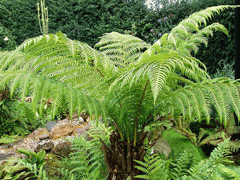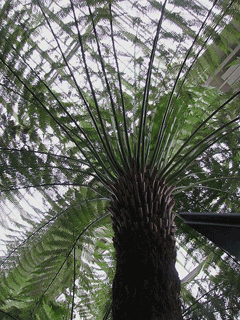 |
|
http://www.flickr.com/photos/pikerslanefarm/2771361328/ |
 |
| http://commons.wikimedia.org/wiki/User:Mmparedes |
Translate this page:
Summary
Physical Characteristics

 Dicksonia antarctica is an evergreen Fern growing to 9 m (29ft) by 4 m (13ft) at a slow rate.
Dicksonia antarctica is an evergreen Fern growing to 9 m (29ft) by 4 m (13ft) at a slow rate.
See above for USDA hardiness. It is hardy to UK zone 8 and is frost tender. It is in leaf all year.
Suitable for: light (sandy), medium (loamy) and heavy (clay) soils. Suitable pH: mildly acid, neutral and basic (mildly alkaline) soils. It can grow in semi-shade (light woodland). It prefers moist soil.
UK Hardiness Map
US Hardiness Map
Synonyms
Plant Habitats
Woodland Garden Dappled Shade; Shady Edge;
Edible Uses
Edible Parts: Leaves Stem
Edible Uses:
The pith in the upper part of the trunk just below the growing point is eaten raw or roasted[46, 61, 154, 193]. It is rich in starch[105, 144] but also contains tannin and is astringent[154]. Descriptions of the taste vary from bitter to sweet, astringent and like a bad turnip[193]. The core of the plant near the growing tip is used[193]. Harvesting the stem kills the plant so this use cannot normally be condoned[193]. The stem contains about 61 kilocalories per 100g[193]. Young leaves - cooked. Harvested just before they unfurl, they are juicy and slimy, tasting like bitter celery[193].
References More on Edible Uses
Medicinal Uses
Plants For A Future can not take any responsibility for any adverse effects from the use of plants. Always seek advice from a professional before using a plant medicinally.
Astringent
Astringent[154].
References More on Medicinal Uses
The Bookshop: Edible Plant Books
Our Latest books on Perennial Plants For Food Forests and Permaculture Gardens in paperback or digital formats.

Edible Tropical Plants
Food Forest Plants for Hotter Conditions: 250+ Plants For Tropical Food Forests & Permaculture Gardens.
More

Edible Temperate Plants
Plants for Your Food Forest: 500 Plants for Temperate Food Forests & Permaculture Gardens.
More

More Books
PFAF have eight books available in paperback and digital formats. Browse the shop for more information.
Shop Now
Other Uses
Soil stabilization
This species is used in New Zealand to stabilize roadside cuttings[200].
Special Uses
References More on Other Uses
Cultivation details
Requires a sheltered woodland position and a moist soil[11, 200]. Strongly resents drought or dryness at the roots[200]. A very ornamental plant[1], it is hardy to about -5°c[184, 200], succeeding outdoors in the milder areas of Britain where it thrives and often self-sows in Cornish gardens[49]. One report says that some forms are hardy to at least -7°c[157]. Plants can tolerate snow but are intolerant of severe frosts[11, 200]. Members of this genus are rarely if ever troubled by browsing deer[233]. The 'trunk' of this plant is merely the decaying remains of earlier growth of the plant and forms a medium through which the roots grow[157]. Plants can be cut down and, if they are kept moist, the top portions can be replanted and will form new roots[157]. The stump, however, will not regenerate since it is simply dead organic matter[157]. It is best to leave old fronds on the plant in order to protect the trunk from cold and desiccation[166].
References Carbon Farming Information and Carbon Sequestration Information
Temperature Converter
Type a value in the Celsius field to convert the value to Fahrenheit:
Fahrenheit:
The PFAF Bookshop
Plants For A Future have a number of books available in paperback and digital form. Book titles include Edible Plants, Edible Perennials, Edible Trees,Edible Shrubs, Woodland Gardening, and Temperate Food Forest Plants. Our new book is Food Forest Plants For Hotter Conditions (Tropical and Sub-Tropical).
Shop Now
Plant Propagation
Spores - can be sown at any time in a warm greenhouse. Surface sow and enclose the pot in a plastic bag in order to keep it moist. Place in light shade. Germinates in 1 - 3 months at 20°c. Prick out small clumps of plants when they are large enough to handle and grow on in a shaded part of the greenhouse for at least the first 2 years. Plant out in late spring after the last expected frosts. The spores can be stored dry for up to 10 years[200].
Other Names
If available other names are mentioned here
Native Range
AUSTRALASIA: Australia (Tasmania, New South Wales, Queensland, South Australia, Victoria, Australian Capital Territory)
Weed Potential
Right plant wrong place. We are currently updating this section.
Please note that a plant may be invasive in one area but may not in your area so it's worth checking.
Conservation Status
IUCN Red List of Threatened Plants Status :

Growth: S = slow M = medium F = fast. Soil: L = light (sandy) M = medium H = heavy (clay). pH: A = acid N = neutral B = basic (alkaline). Shade: F = full shade S = semi-shade N = no shade. Moisture: D = dry M = Moist We = wet Wa = water.
Now available:
Food Forest Plants for Mediterranean Conditions
350+ Perennial Plants For Mediterranean and Drier Food Forests and Permaculture Gardens.
[Paperback and eBook]
This is the third in Plants For A Future's series of plant guides for food forests tailored to
specific climate zones. Following volumes on temperate and tropical ecosystems, this book focuses
on species suited to Mediterranean conditions—regions with hot, dry summers and cool, wet winters,
often facing the added challenge of climate change.
Read More
Expert comment
Author
Labill.
Botanical References
11200
Links / References
For a list of references used on this page please go here
Readers comment